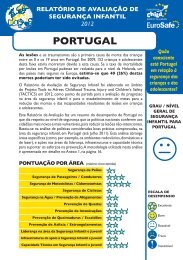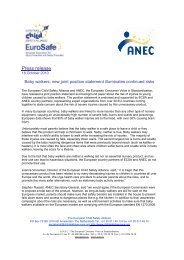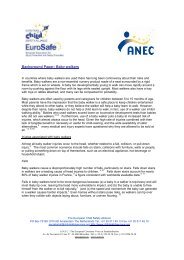Childhood Falls Facts - European Child Safety Alliance
Childhood Falls Facts - European Child Safety Alliance
Childhood Falls Facts - European Child Safety Alliance
You also want an ePaper? Increase the reach of your titles
YUMPU automatically turns print PDFs into web optimized ePapers that Google loves.
<strong><strong>Child</strong>hood</strong> <strong>Falls</strong><br />
<strong>Falls</strong> are the fourth leading cause of child<br />
injury deaths in the <strong>European</strong> region for<br />
children aged 0-19 1 . Where hospitalisation<br />
and emergency department data are<br />
available, we see that falls for children<br />
are the leading cause of admissions and<br />
emergency visits 2 .<br />
A fall is defined as an event that results in<br />
a person coming to rest inadvertently on<br />
the ground or floor or other lower level 3 .<br />
Younger children are at greatest risk of<br />
falling because their urge to explore their<br />
surroundings, usually does not match<br />
their capacity to assess or react to risk 4 .<br />
In Greece falls are a common cause of<br />
serious injuries in infants with an estimated<br />
4,400 infant fall injuries annually 8 .<br />
One out of ten infants requires hospitalisation,<br />
often due to concussions or<br />
fractures. More than 36% of these falls<br />
involved nursery equipment.<br />
In the United Kingdom in 2002 an estimated<br />
390,800 children under 15 were<br />
taken to hospital with injuries resulting<br />
from a fall at home. <strong>Falls</strong> in the home and<br />
garden accounted for nearly half of all<br />
home accidental injuries and almost 60%<br />
of children who went to hospital after<br />
falling at home were under five years of<br />
age. Boys were also more likely to be<br />
injured than girls, making up 56% of<br />
children under five injured due to falls 2 .<br />
Adolescents are also at greater risk as<br />
they often undertake more challenging or<br />
risky actions, which can involve not only<br />
more demanding physical movement but<br />
also more dangerous settings such as<br />
abandoned work sites 5 .<br />
A Hungarian survey, examining children<br />
and young people aged 11-17 year in<br />
2006, found that falls were more prevalent<br />
in younger age groups and that they<br />
accounted for 42% of the most serious<br />
medically treated injuries; they occurred<br />
in sport halls, streets and roads, the<br />
home and school 6 .<br />
<strong>Falls</strong> resulting in severe or fatal injuries<br />
are usually due to falls from second story<br />
or higher windows, balconies and stairs.<br />
The most common type of fall leading to<br />
hospitalisation is from one level to another,<br />
such as from change tables, stairs,<br />
chairs, beds/bunk beds, windows, balconies<br />
and playground equipment 7 .<br />
The majority of falls to a lower level<br />
causing injuries among young children<br />
are related to manufactured products,<br />
such as ordinary household furniture 8 .<br />
These fall injuries require medical attention<br />
and even admission to hospitals. The<br />
majority of the furniture involved in causing<br />
a fall is of seemingly insignificant<br />
height, such as ordinary beds, chairs and<br />
sofas 9 .<br />
Baby walkers are also common causes of<br />
fall injuries in young children due to the<br />
extra mobility and speed, causing children<br />
in walkers to fall down stairs 10 .<br />
Efforts have been made to redesign<br />
walkers, but all attempts to date still leave<br />
a product on the market that is very<br />
dangerous to children. Elimination of<br />
baby walkers is being promoted as the<br />
safest strategy at present 11 .<br />
Prevention Effectiveness<br />
As the leading cause of children’s hospitalisations,<br />
more effort should be made<br />
throughout Europe to reduce fall injuries.<br />
The following measures have been proven<br />
to reduce the risk of a fall happening or to<br />
reduce the severity of injury in the event of<br />
a fall:<br />
Stair gates – have been shown to assist<br />
in the reduction of falls down stairs to<br />
young children when fitted securely at the<br />
top and bottom of stairs 12 .<br />
Stair design – estimates from the United<br />
Kingdom indicate that increasing the<br />
depth of stair treads in new dwellings<br />
would prevent over 1250 falls and probably<br />
2 deaths within the first five years of<br />
enacting a new standard 13 .<br />
Window restrictors – a 96% reduction in<br />
fall admissions occurred after implementation<br />
of a regulation requiring window<br />
bars 7 .<br />
Voluntary product standards – a voluntary<br />
baby walker standard introduced in<br />
1997 in the United States to make walkers<br />
wider than doorframes, to stop at the<br />
top of the stairs without falling over, and<br />
to change the number and design of the<br />
caster wheels resulted in a 63% decrease<br />
in emergency department visits due to
walker injuries 15 . As well, removing the<br />
wheels from or applying brake mechanisms<br />
to baby walkers may prevent falls 9 .<br />
Recommended Policy Actions<br />
Legislation<br />
For Member States to amend building<br />
codes for new dwellings to require window<br />
stoppers and child resistant safety catches<br />
that limit the opening to less than 100mm<br />
on all second story or higher windows.<br />
For EU harmonised building codes for<br />
new dwellings to require all steps and<br />
References<br />
1. The global burden of disease: 2004 update.<br />
Geneva, World Health Organization, 2008<br />
(http://www.who.int/healthinfo/<br />
global_burden_disease/2004_report_update/<br />
en/index.html, accessed 10 November 2008).<br />
2. Vincenten J. Priorities for <strong>Child</strong> <strong>Safety</strong> in the<br />
<strong>European</strong> Union: Agenda for Action. Amsterdam,<br />
ECOSA, 2004.<br />
3. Peden M et al. World report on child injury<br />
prevention. Geneva, World Health Organization<br />
(in press).<br />
4. Jordan J, Valdes-Lazo F. Education on safety<br />
and risk. In: Manciaux M, Romer C, eds. Accidents<br />
in childhood and adolescence: the role<br />
of research. Geneva, World Health Organization,<br />
1991.<br />
5. Morrison A, Stone D. Unintentional childhood<br />
injury mortality in Europe 1984-93: a report<br />
from the WHO Regional Office for EuropeRISC<br />
Working Group. Injury Prevention,<br />
1999,5:171-176.<br />
6. Pall G, ed. Injuries, accidents. Health and lifestyle<br />
of adolescents. National Research Report<br />
of Health Behaviour in School-aged children<br />
2006 survey. Budapest, National Institute<br />
of <strong>Child</strong>e Health, 2007.<br />
7. <strong>Child</strong> Accident Prevention Trust, <strong>Facts</strong>heet:<br />
<strong>Falls</strong> in the Home. Accessed November 30,<br />
2004. http://www.capt.org.uk/FAQ/default.htm<br />
8. Dedoukou X, Spyridopoulos T, Kedikoglou S,<br />
Alexe DM, Dessypris N, Petridou E. Incidence<br />
and risk factors of fall injuries among infants:<br />
a study in Greece. Arch Pediatr Adolesc Med.<br />
2004 Oct;158(10):1002-6.<br />
staircases to have a rise not exceeding<br />
170mm and a tread depth of at least<br />
250mm, as well as barriers on balconies,<br />
stairs and galleries to prevent falling<br />
(including underneath the railing).<br />
For the <strong>European</strong> Commission to ban<br />
baby walkers, except for ‘stationary walkers’<br />
that allow no mobility.<br />
EU Collaboration<br />
For the <strong>European</strong> Commission to support<br />
a <strong>European</strong>-wide campaign on the topic of<br />
falls from heights in children.<br />
9. Harbourview Injury Prevention and Research<br />
Center / Cochrane Collaboration, Systematic<br />
Review Database. Seattle, University of<br />
Washington, 2001.<br />
10. Nordin H. <strong>Falls</strong> among Young <strong>Child</strong>ren in Five<br />
<strong>European</strong> Countries: Injuries requiring medical<br />
attention following falls to a lower level<br />
among 0-4-year-olds. A study of EHLASS<br />
data from Austria, Denmark, Greece, the<br />
Netherlands and Sweden. Stockholm, Swedish<br />
Consumer Agency, 2004.<br />
11. Sabir 2008; Claudet 2006; AAP 2001;<br />
Emanuelson 2003; ANEC 2008; Al-Nouri<br />
2005.<br />
12. Macgregor D. Injuries associated with falls<br />
from beds. Injury Prevention. 2000 Dec;6<br />
(4):291-2.<br />
13. Coats T, Allen M. Baby walker related injuries<br />
– a continuing problem. Archives of Emergency<br />
Medicine, 1991;8: 52-55.<br />
14. Gunatilaka A, Clapperton A, Cassell E. Preventing<br />
home fall injuries: structural and design<br />
issues and solutions. Hazard (Edition No.<br />
59), Summer. Victoria, Victorian Injury Surveillance<br />
& Applied Research System<br />
(VISAR) at the Monash University Accident<br />
Research Centre, 2005.<br />
15. Roys M. Serious stair injuries can be prevented<br />
by improved stair design. Appl Ergon.<br />
2001 Apr;32(2):135-9.<br />
(Printed October 2009)<br />
The <strong>European</strong> <strong>Child</strong> <strong>Safety</strong> <strong>Alliance</strong> is a Programme of EuroSafe and is hosted by the Consumer <strong>Safety</strong> Institute in the Netherlands<br />
PO Box 75169 1070 AD Amsterdam The Netherlands Tel. +31 20 511 45 13 Fax +31 20 511 45 10<br />
secretariat@childsafetyeurope.org http://www.childsafetyeurope.org





